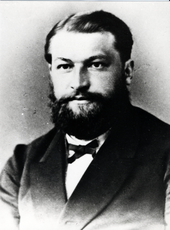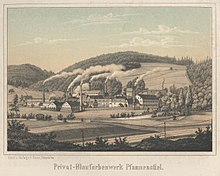Clemens Winkler
Clemens Alexander Winkler (born December 26, 1838 in Freiberg , † October 8, 1904 in Dresden ) was a German chemist . He is the discoverer of the chemical element germanium .
family
Clemens Winkler was born as the second eldest son of the three sons and three daughters of the metallurgist Kurt Alexander Winkler and his wife Elmonde Winkler née Schramm. He was a nephew of the mineralogist August Breithaupt and cousin of the geologist Hermann Theodor Breithaupt . His godfather was the chemist Ferdinand Reich . The chemist Ferdinand Bischoff was his brother-in-law.
life and work
After initially receiving private tuition with his siblings, he went to the grammar school in Freiberg at the age of twelve, from which he switched to the secondary school in Dresden and after two years to the trade school in Chemnitz . After his stay at the Chemnitz trade school (1853-1856) he began studying at the Freiberg Bergakademie (1857-1859), but broke it off after two years at the request of his sick father. He first worked as a chemist in the Oberschlema blue paint factories and, after his father's death in 1862, in Niederpfannenstiel . He then founded a family with Minna Pohl in Pfannenstiel, which resulted in four sons and two daughters. In the following two years, he published nine works and was in 1864 for his work About Siliciumlegirungen and silicon metals arsenic at the University of Leipzig PhD ; In the same year he became a smelter in the Niederpfannenstiel blue paint factory .
Winkler also had time there for his own experiments. He examined the reactions of the element indium - which his former teacher Ferdinand Reich had discovered -, determined the atomic weight, determined the bivalent value and represented a large number of indium salts. He determined the atomic weights of nickel and cobalt .
On the recommendation of Hermann Kolbe , Clemens Winkler was appointed to succeed Theodor Scheerer as professor of inorganic chemistry at the Bergakademie Freiberg in 1873 , although he had not previously taught as a smelter. His first work was on mineral analysis; Winkler used electrical analysis for the weight analysis of types of metal. Winkler introduced the platinum wire mesh electrode in 1898 and is considered a co-founder of electrical analysis .
As early as 1831 in England, Peregrine Phillips had received a patent for the production of sulfuric acid from sulfur dioxide through contact with platinum. Winkler developed platinum-coated asbestos for the same purpose and obtained a very high yield of sulfuric acid. In 1876 a sulfuric acid factory was established near Freiberg. Winkler was a co-founder of the contact process and recognized arsenic as a contact poison that worsened the effectiveness of the catalyst. The BASF chemist Rudolf Knietsch later developed the process further and it found worldwide recognition.
Winkler improved Robert Bunsen's gas analytical methods and simplified them to such an extent that they were widely used in industry; he developed the gas burette named after him and, together with the chemist Walther Hempel, is considered to be the founder of technical gas analysis .
Winkler's most important achievement was the discovery of the element germanium on February 6, 1886. When analyzing the rare mineral argyrodite , he found that this consisted of approx. 75 percent silver , 17 percent sulfur and small amounts (approx. 1 percent) consisted of iron , mercury and zinc . Now there were still seven percent missing to the whole. After several months of work, Winkler was finally able to isolate a new element with the help of the Freiberg exposure, which he called germanium - based on the naming of the elements gallium and scandium . His discovery confirmed the theoretical work done by Dmitri Ivanovich Mendeleev , who had predicted the existence of an element he called eka-silicon with these properties.
In 1894 he first met Mendeleev, with whom he had been in correspondence since 1886. From 1896 to 1899 Winkler was director of the Bergakademie; He declined appointments to other universities. He died in 1904 at the age of 65 years to cancer .
Clemens Winkler was a member of the Weinheimer Corps Franconia Freiberg . He is buried in the Trinity Cemetery in Dresden.
Honors
- Elected to the German Academy of Sciences Leopoldina (1878)
- Elected full member of the Royal Saxon Society of Sciences (1890)
- Appointment as a secret mountain ridge (1894) and a privy councilor by the Saxon government (1899)
- Honorary Citizen of Freiberg (1899)
- Dr.-Ing. e. H. of the Technical University of Charlottenburg (1902)
- Memorial plaque of the Society of German Chemists at the old chemical laboratory, Historic Sites of Chemistry (2008)
- The first grammar school in Aue (Saxony) and the middle school in Freiberg bear Winkler's name.
Publications
Clemens Winkler's work comprises 141 publications .
- About the chemical composition of condurite , 1859
- Instructions for the chemical investigation of industrial gases , 1876/79
- Proof of firedamp in coal mines , 1878
- Textbook of technical gas analysis , 1885
- Practical exercises for dimensional analysis , 1888
See also
literature
- Mike Haustein: Clemens Winkler: Chemistry was his life . Verlag Harri Deutsch, Frankfurt am Main, ISBN 3-8171-1728-0 .
- O. Brunck: Clemens Winkler . In: Reports of the German Chemical Society . tape 39 , no. 4 , November 1906, p. 4491-4548 , doi : 10.1002 / cber.190603904164 .
- C. Schiffner: From the life of old Freiberg mountain students. E. Maukisch, Freiberg 1935, pp. 48-54.
- HCA Winkler, A. Lissner, A. Lange and R. Prokop: Clemens Winkler: To his memory. Commemorative script for the 50th anniversary of his death . Akademie Verlag, Berlin 1954 (= Freiberg research books D8).
- Stadtverwaltung Aue (ed.): Aue, mosaic stones of history . Printing and publishing house Mike Rockstroh, Aue 1997, p. 63.
- Manfred Bachmann (ed.): Prof. Clemens Winkler - discoverer of germanium. In: Small chronicle of great masters - Erzgebirge we are proud of. Part 1, printer and publisher Mike Rockstroh, Aue 2000, pp. 38–39.
- Horst-Ulrich Textor: The search for lost percentages. On the 100th anniversary of the death of Clemens Winkler, the discoverer of germanium . Then and now . Volume 50 (2005), pp. 457-470.
Web links
- On the trail of the unknown: because the rock analysis was missing seven percent, Clemens Winkler discovered germanium
- Literature by and about Clemens Winkler in the catalog of the German National Library
- Literature by and about Clemens Winkler in the Saxon Bibliography
- Article by / about Clemens Winkler in the Polytechnisches Journal
Individual evidence
- ↑ a b Klaus Volke: Clemens Winkler and environmental protection: On the 100th anniversary of the death of the most important Freiberg chemist . In: Communications of the specialist group . tape 17 , 2004, p. 111-130 ( gdch.de [PDF]).
- ↑ a b c O. Brunck: Clemens Winkler . In: Reports of the German Chemical Society . tape 39 , no. 4 , November 1906, p. 4491-4548 , doi : 10.1002 / cber.190603904164 .
- ^ René Du Bois-Reymond, Carl Schaefer: Handbook for the history of natural sciences and technology . In chronological representation. Ed .: Ludwig Darmstaedter. 2nd Edition. Springer-Verlag, Berlin Heidelberg 1908, ISBN 978-3-662-42867-2 , chap. 1898 , p. 972 , doi : 10.1007 / 978-3-662-43152-8 ( limited preview in Google book search).
- ↑ Cl. Winkler, Germanium, Ge, a new, non-metallic element, reports of the German Chemical Society , 1886, Volume 19, p. 210.
- ^ Member entry of Clemens Winkler at the German Academy of Natural Scientists Leopoldina , accessed on December 28, 2015.
- ^ Members of the SAW: Clemens Winkler. Saxon Academy of Sciences, accessed December 14, 2016 .
| personal data | |
|---|---|
| SURNAME | Winkler, Clemens |
| ALTERNATIVE NAMES | Winkler, Clemens Alexander (full name) |
| SHORT DESCRIPTION | German chemist, discoverer of germanium |
| DATE OF BIRTH | December 26, 1838 |
| PLACE OF BIRTH | Freiberg |
| DATE OF DEATH | October 8, 1904 |
| Place of death | Dresden |






